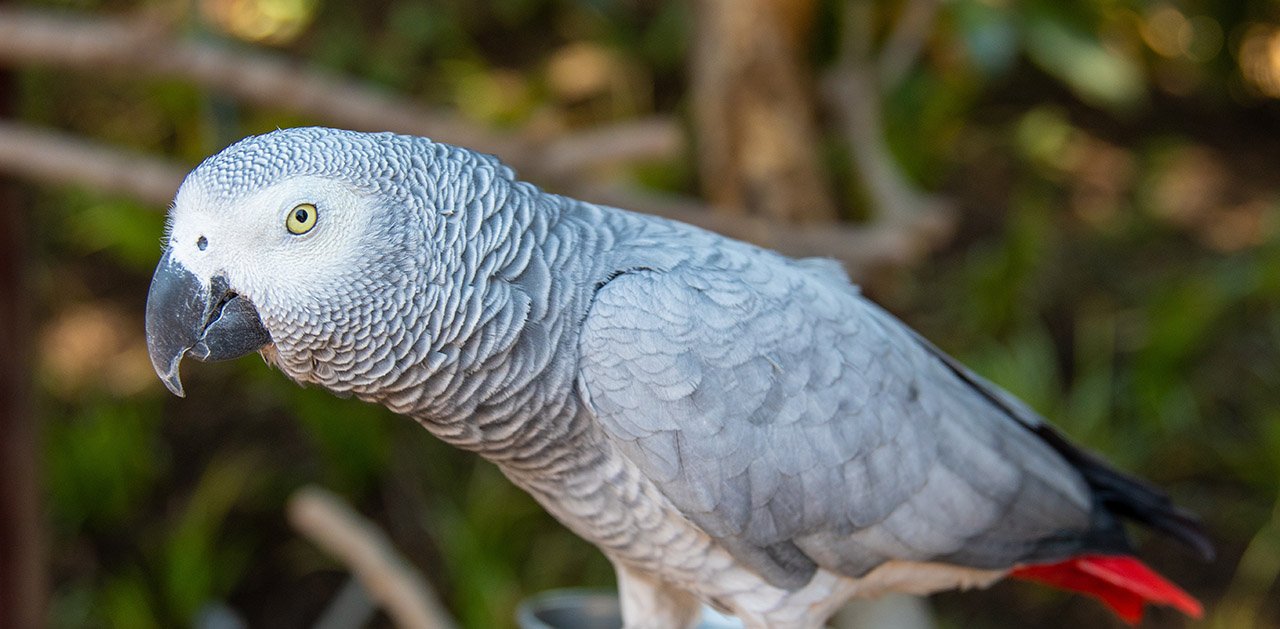Introduction
The African Grey Parrot is often regarded as the Einstein of the bird world. Known for its remarkable intelligence and ability to mimic human speech, this bird is highly prized as a pet. Native to the rainforests of Central and West Africa, it stands out not only because of its cognitive abilities but also for its long lifespan, sometimes living up to 60 years in captivity. Let’s explore what makes the African Grey Parrot truly unique and how to care for one.
Types of African Grey Parrots
There are two main subspecies of the African Grey Parrot: the Congo African Grey and the Timneh African Grey. While both share many similarities, such as intelligence and general appearance, they differ in size and slight coloration:
- Congo African Grey: The larger of the two, measuring about 13 inches, this species has light grey plumage and a distinctive red tail. Its beak is solid black.
- Timneh African Grey: Slightly smaller, this bird features darker, charcoal-colored feathers and a maroon tail. It has a horn-colored upper mandible.
Both subspecies are equally intelligent, capable of learning hundreds of words, sounds, and even basic problem-solving skills.
Intelligence and Communication
The African Grey Parrot’s intelligence is well documented. They can develop a vocabulary of up to 1,000 words and have been proven to understand context. Unlike simple mimicking, many African Greys can associate words with meaning, making them much more than just sound imitators. In fact, some birds have demonstrated the ability to perform tasks involving numbers, colors, and shapes.
One famous African Grey, named Alex, was part of a 30-year study by animal psychologist Irene Pepperberg, where he demonstrated an understanding of concepts such as shape, color, and quantity, showing cognitive abilities similar to a 5-year-old child.
Housing and Enrichment
To accommodate this highly intelligent bird, it’s crucial to provide an enriching environment. An African Grey Parrot’s cage should be spacious—at least 2 feet by 2 feet with a height of 3 feet—to allow room for flying and exercise. Mental stimulation is just as important, if not more so. Boredom can lead to destructive behaviors, such as feather plucking or excessive screeching.
Toys and puzzles are essential for these birds. They enjoy toys they can manipulate, such as puzzles where they need to unlock compartments to access treats. Regular interaction is also key, as they require social stimulation.
Diet and Nutrition
In the wild, African Grey Parrots eat a varied diet of fruits, seeds, leaves, and even insects. In captivity, they should be fed a high-quality pellet diet, along with fresh fruits and vegetables like kale, spinach, apples, and carrots. African Greys are prone to vitamin deficiencies, especially in calcium and Vitamin A, so it’s crucial to provide them with a balanced diet
Calcium deficiencies can lead to health issues such as hypocalcemia, which may cause tremors or difficulty perching. To combat this, provide mineral supplements and a variety of fresh greens
Behavior and Temperament
African Greys are incredibly social birds, but they can also be emotionally sensitive. They form strong bonds with their owners and can become “one-person birds,” showing preference for one individual over others. This attachment, while endearing, can become problematic if the bird does not receive enough attention or mental stimulation.
Although generally not aggressive, a neglected African Grey may develop behavioral issues, including feather plucking or aggressive screeching. These birds thrive on interaction, so consistent training and socialization are necessary to keep them mentally healthy.
Health Concerns
African Greys are susceptible to a variety of health issues, including:
- Feather Plucking: A sign of stress or boredom, feather plucking can be a serious behavioral problem if not addressed promptly. Ensuring the bird has sufficient mental and physical stimulation is key to preventing this.
- Hypocalcemia: This calcium deficiency is common in African Greys. It can lead to tremors and, in severe cases, seizures. Providing a calcium-rich diet and supplements helps mitigate this issue.
- Psittacine Beak and Feather Disease (PBFD): A viral disease that affects the beak, feathers, and immune system of parrots, PBFD is often fatal. There is no cure, but maintaining good hygiene and providing a stress-free environment can help prevent infection.
Training and Socialization
Training an African Grey Parrot requires patience and consistency. They can be taught to speak, mimic household sounds, and perform tricks. Training should be positive and reward-based. Many owners report that African Greys thrive on the challenge of learning new words and behaviors. It’s essential to start early, as the first few years are critical for socialization.
Adopting an African Grey Parrot
If you’re considering adopting an African Grey Parrot, it’s important to recognize the commitment involved. With a lifespan of up to 60 years, owning an African Grey is a long-term commitment. They require daily mental stimulation, a healthy diet, and regular social interaction.
When purchasing a parrot, it’s best to work with reputable breeders or adoption agencies to ensure you’re getting a healthy bird. Avoid supporting illegal trade, as these birds are protected by international law
Conclusion
The African Grey Parrot is much more than just a pet—it is a lifelong companion that requires significant time, effort, and care. In return, you’ll gain a friend that can engage with you on an intellectual level, mimic your speech, and surprise you with its problem-solving abilities. Owning an African Grey is incredibly rewarding, but it’s important to understand and meet their complex needs for a happy and healthy life.
